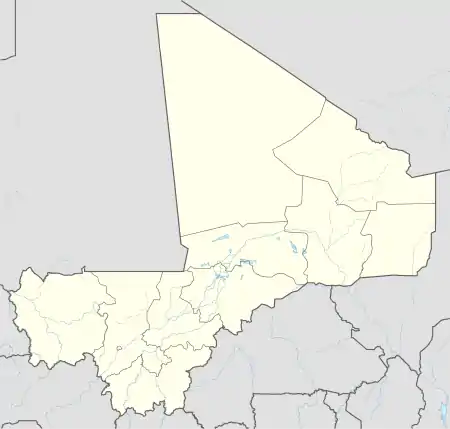Kita, Mali
Kita is a town and urban commune in western Mali. The town is the capital of the Kita Cercle in the Kayes Region. It lies on the eastern slope of Mount Kita (Bambara: "Kita-kulu"), known for its caves and rock paintings. Today, the town is known for its music, its annual Roman Catholic pilgrimage and its role as a processing center for the surrounding cotton- and peanut-growing region. Kita lies on the Dakar-Niger Railway and is the largest transit hub between Bamako (112 miles) and Kayes (205 miles). In the 2018 census the urban commune had a population of 463,787.[1]
Kita | |
|---|---|
Commune and town | |
 | |
 Kita Location in Mali | |
| Coordinates: 13°2′20″N 9°29′15″W | |
| Country | |
| Region | Kayes Region |
| Cercle | Kita Cercle |
| Elevation | 330 m (1,080 ft) |
| Population (2018 census)[1] | |
| • Total | 463,787 |
In November 1955, Kita became a commune of average exercise. On March 2, 1966, Kita became a commune of full exercise. The town grew in the 1990s around the cotton industry, but this has since declined.
A fictionalized version of Kita features as the setting for Malian author Massa Makan Diabaté's "Kouta Trilogy" (Le lieutenant de Kouta, Le coiffeur de Kouta, and Le boucher de Kouta).[2]
History
Name
Kita proper has been called with different names throughout history. One of its earliest names was "Guénou Kourou".[3]
However, a second name "Sediousaba"[4] had been used for the small village, or rather an area in the town.
Birth & Settlements
Two major settlements have been considered the birth of the town of Kita, however the order of these settlements are still subjects to debate. One of the settlements was attributed to the Tounkara traders from Ouagadou, the Ghana empire. Their chief, Diouna Tounkara, created "Sediousaba",[4] which means "Three shea trees" as mentioned above. The second settlement was attributed to a Guinea trader, Siema Toloba Kamara, who created a village called "Fatali. Later, Siema Toloba Kamara and Diouna Tounkara allied with each other to form a new village called "Linguékoto".[4]
Population
In the Health Minister's 2018 census, Kita had a population of 463,787,[5] while in 2020, the urban area of Kita counted 65,908.
Climate
Kita has a fairly dry tropical savanna climate (Köppen Aw) with a hot to sweltering and arid dry season from November to late May and a hot, steamy wet season from late May to October. There is negligible rain and very low humidity in the dry season, whilst in the wet season rainfall totals around 900 millimetres or 35 inches with oppressive and uncomfortable humidity.
| Climate data for Kita climate station (334 metres or 1,096 feet elevation) 1991-2020 averages | |||||||||||||
|---|---|---|---|---|---|---|---|---|---|---|---|---|---|
| Month | Jan | Feb | Mar | Apr | May | Jun | Jul | Aug | Sep | Oct | Nov | Dec | Year |
| Average high °C (°F) | 33.6 (92.5) |
36.0 (96.8) |
39.1 (102.4) |
40.6 (105.1) |
39.3 (102.7) |
35.8 (96.4) |
32.1 (89.8) |
30.1 (86.2) |
32.1 (89.8) |
34.6 (94.3) |
35.8 (96.4) |
34.2 (93.6) |
35.2 (95.4) |
| Average low °C (°F) | 19.5 (67.1) |
22.1 (71.8) |
25.4 (77.7) |
28.0 (82.4) |
27.5 (81.5) |
25.3 (77.5) |
23.5 (74.3) |
22.9 (73.2) |
22.9 (73.2) |
22.8 (73.0) |
20.2 (68.4) |
19.1 (66.4) |
23.1 (73.6) |
| Average rainfall mm (inches) | 0.6 (0.02) |
6.2 (0.24) |
7.6 (0.30) |
9.8 (0.39) |
39.6 (1.56) |
121.9 (4.80) |
200.5 (7.89) |
254.5 (10.02) |
195.2 (7.69) |
60.1 (2.37) |
2.1 (0.08) |
0.4 (0.02) |
930.0 (36.61) |
| Average rainy days (≥ 1.0 mm) | 0.16 | 0.05 | 0.29 | 1.17 | 4.43 | 9.23 | 13.19 | 15.55 | 13.59 | 5.73 | 0.37 | 0.15 | 64.24 |
| Mean monthly sunshine hours | 249.7 | 250.6 | 290.4 | 269.5 | 262.3 | 243.4 | 202.9 | 191.0 | 217.0 | 268.2 | 254.3 | 254.4 | 2,931.7 |
| Source: Meteo Climat[6] | |||||||||||||
Notable residents
- Sekou Koita, International Soccer player
- Bako Dagnon, female griot
- Cheick Hamala Diabate, griot and Afropop musician
- Mamadou Diabate, master kora player
- Massa Makan Diabaté, historian, author, and playwright
- Kandia Kouyaté, musician
- Djelimady Tounkara, musician and one of the foremost guitarists in Africa
See also
References
- ANNUAIRE STATISTIQUE 2018 DU SYSTEME LOCAL D'INFORMATION SANITAIRE DU MALI (PDF) (in French), République de Mali: Ministere de la Sante et du Développement Social".
- Drame, Kandioura. "Diabaté, Massa Makan." The Encyclopedia of African Literatures. Ed. Simon Gikandi. p. 195.
- KEITA, MADIBA (22 July 2019). "Le saviez-vous ?: LES MILLE ET UN MYSTÈRES DE KITA". ESSOR.
- TELLIER, G (1902). Autour de Kita - Etude Soudanaise (in French). Imprimerie et Librairie Henri Charles-Lavauzelle. p. 33.
- Ministère de la Santé et de l’Hygiène Publique. "Annuaire Statistique 2018 du Système Local d'Information Sanitaire ANNUAIRE STATISTIQUE 2018 DU SYSTEME LOCAL D'INFORMATION SANITAIRE DU MALI" (PDF). sante.gov.ml. Retrieved August 12, 2022.
- "Climate Normals 1991-2020". Meteo Climat. Retrieved 11 April 2021.
External links
- Plan de Sécurité Alimentaire Commune Urbaine de Kita 2007-2011 (PDF) (in French), Commissariat à la Sécurité Alimentaire, République du Mali, USAID-Mali, 2006, archived from the original (PDF) on 2012-09-17, retrieved 2012-05-12.
